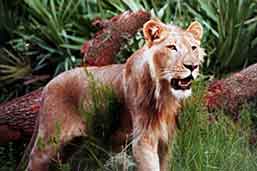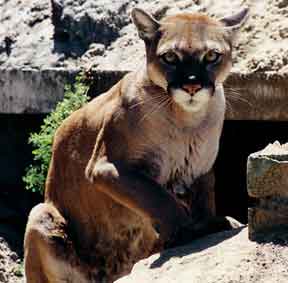|
Hurts Them
|
|
|
It's
a jungle out there for exotic animals in Florida. The Florida climate and convenience of major ports is also breeding a stampede of breeders and dealers of exotic animals, many unlicensed by the U.S. Department of Agriculture. Florida has 135 licensed USDA facilities (the state of New York only has 47 such licensees), but there are hundreds, maybe thousands of exotic animal owners, breeders and dealers that are licensed by the state but do not have USDA licenses.
There are problems with the lack of regulation regarding the practices of these exotic animal compounds. The state of Florida has the exclusive power to govern the wildlife but it lacks the stringent standards and manpower to enforce them. Even though the state knows where many of these facilities are, there are no required census nor registration of individual animals and thus no way to know how many are being bought, bred, sold or turned loose. Animals who could either not survive a harsher winter, or who would only reproduce seasonally in other areas of the country flourish in Florida and reproduce year round. Profiteers from the sale of exotic animals flock to Florida to take advantage of a climate that produces more babies to sell each year. When people try to circumvent nature there is a price to pay. Animals who are bred more frequently than they would in their native habitat die younger and the immune systems of their offspring are often compromised. In the wild, a tiger would breed and raise a litter once every 3-5 years because the mother trains her cubs how to exist in the wild. In captivity, tigers are often bred three times a year. The mother’s body cannot supply enough of itself to create 2 or 3 healthy litters each year, so the offspring usually suffer from paper-shell bones and a myriad of heath problems. Unscrupulous
breeders often focus on the short term profits generated by selling these
cubs at 6-8 weeks of age. The new buyer is the one who will be dealing
with the hip displasia and other medical costs. By the time the cat is
a year old they will be looking for a place to get rid of their very expensive,
150 pound, dangerous pet.
Carole
Lewis, the founder of Big Cat Rescue in Tampa, points out, "We had
to turn away 311 big cats last year due to a lack of funds to be able
to take on responsibility for them for the next 20 years. This number
of cats we have to turn away doubles each year. 85% of our exotic cats
were a result of the pet and entertainment /edutainment industry." "These people set themselves up as non-profits and solicit donations to enable them to stay home and breed and sell more animals into a life of misery," Lewis adds.
What can be done? To protect Florida’s natural habitat and native species, better laws and tougher enforcement are needed. "There is no excuse for people to be breeding exotic animals outside of the Species Survival Plan," says Lewis. "The global plan for breeding animals of known origin in hopes of being able to return them to their native habitats. "Almost all of the people who are truly breeding for conservation purposes are members of the American Zoological Association and all of the true conservationist are members of the Species Survival Plan’s studbooks and follow SSP recommendations. Anyone who is breeding and selling outside of these two organizations is doing so strictly for profit and is harming the specie they claim to be saving by diverting funds to their own pockets rather than to real conservation efforts." If the public understood the difference between these respected groups and the unscrupulous people who are breeding and selling for gain, it would mean an end to the problem, but until then we need our government to define what is a legitimate sanctuary and not allow facilities that breed, sell and exacerbate the unwanted exotic pet problem.
|
 Sierra, the Caracal is still wary of humans even though no one has touched him in over 8 years. Having come from a research facility where only he knows the cruelty he was subjected to every day has caused him to never trust a human being again.
 Nakoma the lion lays in a grave marked by a tombstone with his picture on it. Even in death, he tells his story to visitors about how his owner made money by selling people the opportunity to have their picture made with a cute and cuddly lion cub. In order to keep him small and usable for the longest period possible he was starved and denied the bone building calcium and vitamins that he needed. He was never able to run and walk and before he was three years old (not even an adult yet) his condition, and resulting pain, had deteriorated to the point that euthanasia was his kindest option.  Shere Khan was bred to be a white tiger because zoos would pay $30,000.00 to have one to draw in the paying public. Hundreds of unwanted, golden colored cubs, are born and discarded in order to produce that one "valuable" white cub. The white cats are a genetic fluke that would not be able to exist in the wild and are extremely inbred in order to create a higher ratio of white to golden cubs. They are marketed to the public as being rare and endangered because the public doesn't know that they would never have a place in the wild and are only being bred to pump up attendance for the zoos. Shere Khan was four months old and living full time in a pet carrier, up to his belly in feces because he had the misfortune of being born the wrong color and no one wanted him. He was denied a decent diet and had bones and teeth so brittle that he couldn't walk and his teeth rotted through his skull causing huge weeping sores on his face and chin. Shere Khan came to WildLife on Easy Street early enough to save his adult teeth and to restor his bone strength so that he now swims in the lake and has the run of a three acre Cat-A-Tat at Big Cat rescue. He was the rare one because most end up being killed in canned hunts, sold for parts or dumped into the pet trade where generation upon generation is bred by people claiming to be breeding for conservation purposes.  Cleocatra had been a pet but as she grew, she became harder and harder to handle. Her owners couldn’t remove the nylon harness she always wore because she would bite them. She grew, but the harness didn’t. By the time she came to Big Cat Rescue her body was permanently stunted from being confined in this ratty harness and the poor diet she had been fed. "She is the
tiniest cougar I had ever seen; hardly any bigger than a beagle, but
full grown," says Lewis. The harness had cut into her skin which
had actually grown over it in some places. |
For more information, contact Carole Lewis, Founder, Big Cat Rescue, (formerly WildLife on Easy Street), 12802 Easy Street Tampa, FL 33625. Telephone, 813.920.4130 x5, fax 885.4457. Visit their website at www.BigCatRescue.org, or E-mail her at MakeADifference@verizon.net |